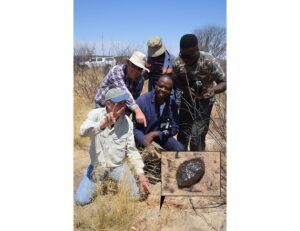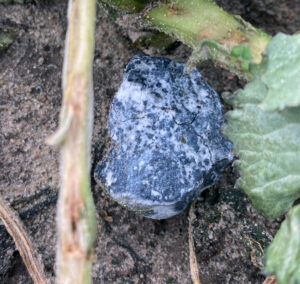
Our Solar System contains a whole lot more than eight planets, two former planets, and a star. There are myriad moons, asteroids, comets, weird neither comets nor asteroids things, and a bunch of small stuff.
And when it comes to Earth protection, we sweat the small stuff.
In recent years, a lot of effort has gone into both transforming discoveries into precise predictions of possible impacts and also into taking images from ground-based cameras and using them to pinpoint where actual impacts may have occurred. Much to my surprise, this allowed researchers to find a meteor that impacted the large Central Kalahari Game Reserve in Botswana. In a place filled with rocks, dirt, animal dung, and the occasional animal that might want to eat you, they found the three-centimeter remnant of what was once a one-meter-across meteoroid.
While not much was in danger when that small rock hit a nature reserve in Botswana, the fear is always that something not so small will impact a region with a high population density.
In the early morning hours of January 21, a small rock streaked in over Europe, causing NASA to warn on social media: “Heads Up: A tiny asteroid will disintegrate as a harmless fireball west of Berlin near Nennhausen shortly at 1:32am CET. Overseers will see it if it’s clear!”
That streak got caught on cameras throughout Germany and as far away as Slovakia.
This object, cataloged as 2024 BX1, was the eighth object detected before hitting the Earth. It was initially discovered by Hungarian astronomer Krisztián Sárneczky three hours before impact and subsequently tracked by NASA’s Near Earth Asteroid Scout and the ESA’s Meerkat Asteroid Guard impact hazard assessment systems. The combined observations from these facilities and others are what allowed that ever-so-accurate NASA warning to go out.

Like the impactor in Botswana, the object that fell over Germany started about one meter across and was reduced to palm-sized meteorites by the time it reached Earth. Somehow – and again, I don’t understand by what magic researchers can do this – a fragment was found under leaves in a planted field.
This meteorite doesn’t look like the kinds of meteorites most of us have seen: it isn’t a melty hunk of iron or a melty hunk of carbon-rich molecules. Instead, this is an aubrite – a gray rock with white crystals that is coated with a clear glassy melt. This is a magnesium-rich kind of meteor that likely formed from magma and some kind of violent origin.
This is actually a pretty rare kind of meteorite, and this rich set of data is going to allow us to piece together its very rough orbit, behavior through the atmosphere, and now the chemistry of the asteroid itself. This is, essentially, a free sample from space that saved us many million dollars, while requiring some keen-eyed researchers to check under a bunch of leaves in a rainy German countryside. Sure, this sample is rather polluted by rain, dirt, humans, and whatever else lived in the dirt and plants, but it was free.
